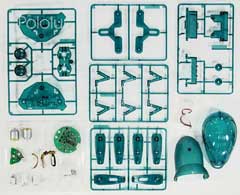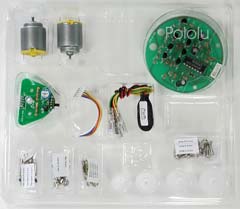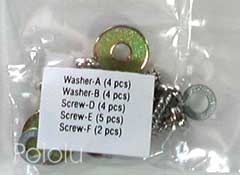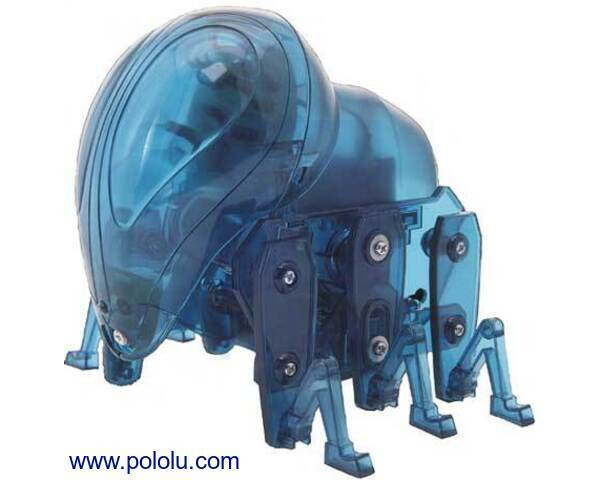iBOTZ MR-1002 Antoid
The iBOTZ Antoid is a unique, beginner-level robot kit that features one of the most basic functions found in autonomous robots: obstacle detection. Powered by two DC motors, the Antoid walks on six legs and avoids bumping into objects by detecting them with an infrared sensor. The robot walks forward until it detects an obstacle, at which point it backs up and turns before resuming its forward gait.
| Description | Specs (0) | Pictures (3) | Resources (1) | FAQs (0) | On the blog (0) | Distributors (0) |
|---|
 |
Antoid Overview
The iBOTZ Antoid is a unique, beginner-level robot kit that features one of the most basic functions found in autonomous robots: obstacle detection. Powered by two DC motors, the Antoid walks on six legs and avoids bumping into objects by detecting them with an infrared sensor. The robot walks forward until it detects an obstacle, at which point it backs up and turns before resuming its forward gait. By assembling the Anotoid robot kit, you will learn one way to create a six-legged robot and gain an appreciation for basic sensors, gearboxes, and electronics.
 |
Kit Contents and Packaging
The Antoid kit comes in a sturdy, colorful box with English text. The kit includes all the parts you need to put it together, including two pre-soldered circuit boards, two DC motors, and high-quality, durable plastic parts that snap and screw together nicely. The first part you’ll notice is the large front shell with a decidedly extraterrestrial look. With six legs, there are quite a few parts spread across five plastic parts trees. All of the plastic has the same blue-green color, with some parts textured and some clear.
 |
The smaller parts come packaged in a separate plastic tray. The small hardware is packaged in labeled bags that is a big help in identifying one part from another. The instructions recommend applying grease to the gearboxes, but none is included in the kit. We found that the robot works fine without grease, though it might be a little louder and wear out a bit sooner.
Assembling the Antoid
Because the printed circuit boards are pre-assembled, putting the Antoid together is largely a mechanical project. All you will need are a small phillips screwdriver and wire cutters.
The Antoid instructions (697k pdf) are generally easy to understand, although we would like to see better identification of the small hardware. All of the hardware is tagged with letters in the parts list at the beginning of the instructions (e.g. "Screw A" is M3 x 10), and the individual assembly steps refer only to those letter designations. We recommend that you separate and label your hardware before you begin to prevent any confusion and to avoid having to flip back to the parts list page over and over.
Here are a few notes to help you avoid potential problems:
- On page 6 (Parts List), the drawings of washers A and B are misleading. Washer A is the very large washer, and washer B is the smaller one.
- Steps 1 and 6 (pages 9 and 12) require the two medium pipe spacers (B). Our kit included four of these B pipe spacers, but only two are necessary. If your kit comes with more than two, make sure to select two that are longer than the thickness of the plastic through which they fit. Don’t forget to use the lock nuts!
- On page 22, the dotted lines indicating the screw holes in the PC board go through the wrong hole drawings. When you look at the PCB, the smaller holes that look like the obvious ones to use are indeed the ones to use. Make sure the white connector is oriented downward.
- Page 23: To prevent an accidental short, make sure you connect the battery holder wires to the PC board before installing your batteries! Also, the wire diagram does not specify which color wire to connect to which motor lead. Just make temporary connections and turn on the robot; if the legs on either side move backward, flip the wires on the corresponding motor.
- We had a bit of difficulty placing the batteries in the battery bay. Make sure not to spread the sides of the body, and make sure the leads are clear of the gears. The 9V battery fits in the side closer to the head.
Letting it Loose!
Like most small walking robot toys, the Antoid performs best on a fairly smooth surface, but we were able to run it without problems even on a carpet of medium thickness. The obstacle sensor consists of a very bright red LED and a phototransistor, and you can adjust the sensitivity. The sensor is very effective: we saw detection of typical (not especially shiny) objects up to six inches away. The flickering red LED is a nice touch that gives a little more insight into the operation of the robot.
The iBOTZ Antoid is a good robot kit for anyone as young as 10 who wants to get into robotics. The robot is fairly straightforward to assemble, yet it is more than just a snap-together kit. Through construction of the robot, you will gain valuable skills that will help you with more advanced projects in the future. As you interact with your Antoid robot, you will gain an appreciation for both the possibilities and the limitations of autonomous robots. Can you find obstacles that the Antoid will not detect? In what environment will the Antoid detect all obstacles?
Note: The iBOTZ Antoid robot is a kit; assembly is required. Two AA alkaline batteries and one 9-volt battery are required but not included.
iBOTZ MR-1002 Antoid Specifications
- Features:
- Adjustable infrared sensor ("eye" for obstacle detection)
- Six-legged walking with two motors
- Actuators: Two DC motors
- Power supply:
- 2 AA alkaline batteries for mechanical section
- 1 nine-volt battery for electronics (batteries not included)
- Current consumption: 7 mA for electronics, 230 mA for mechanical section
- Dimensions: 150 × 180 × 155 mm (L x W x H)






